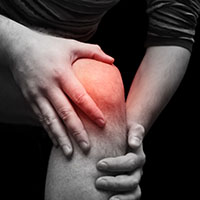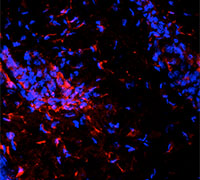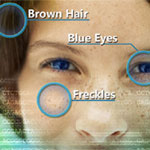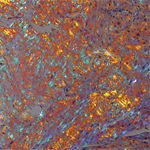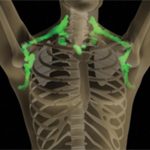Spotlight
Letter from Dr. Stephen I. Katz: Connecting With our NIAMS Coalition Partners
Dear Colleagues:
Last month, I had the pleasure of meeting with representatives from many of the NIAMS Coalition organizations at the NIAMS Coalition Outreach and Education Day. We host this event to provide a forum for our Coalition members to share best practices on connecting science with the public. Coalition members also have an opportunity to learn more about how the National Institutes of Health (NIH) and NIAMS function. The Coalition, a consortium of nearly 90 professional and voluntary organizations concerned with the Institute's programs, are tremendous supporters of the NIAMS and NIH. They are key partners, and serve as the voices of the patients and professionals for whom we work.
Stephen I. Katz, M.D., Ph.D.
Director
National Institute of Arthritis and Musculoskeletal and Skin Diseases
National Institutes of Health
Image: Stephen I. Katz, M.D., Ph.D.
News
Request for Information: Identifying Gaps in Understanding the Mechanisms of Physical Activity-Induced Health Benefits
Increased physical activity has been linked to numerous health benefits, including improved cardiovascular and respiratory health, insulin sensitivity, bone and muscle strength and cognitive function. In addition, physical activity is associated with reductions in coronary heart disease, stroke, some cancers, type 2 diabetes and depression. For most health outcomes, benefits increase as the amount of physical activity increases through higher intensity, greater frequency or longer duration, although the magnitude of these benefits diminishes with advancing age. The NIH Common Fund is exploring strategies to help the research community develop a more integrative perspective on the molecular and cellular mechanisms through which physical activity improves multiple health outcomes. The NIAMS is leading the effort. Comments are being accepted through December 31.
NIAMS Continues To Seek Comments on Long-Range Plan (Fiscal Years 2015–2019)
The NIAMS is updating its Long-Range Plan to help guide the research it supports over the next five years. Gathering public input on the topics included in the plan and suggestions regarding how to enhance the NIAMS research portfolio is a critical initial step in this effort. NIAMS leadership and staff will review and consider the comments. The deadline to submit comments is January 15, 2014.
Reminder: NIAMS 2014 Health Planners Available
The NIAMS has created a series of multicultural health planners for 2014, titled A Year of Health: A Guide to a Healthy 2014 for You and Your Family. These planners, tailored for four multicultural communities (African Americans, American Indians/Alaska Natives/Native Hawaiians, Asian Americans/Pacific Islanders, Hispanics/Latinos), provide research-based health tips and information about staying healthy and managing conditions of the bones, joints, muscles and skin. In addition, the NIAMS created an electronic toolkit with resources to help you and your organization reach out to multicultural communities and distribute the planners effectively. To order A Year of Health planners free of charge, please contact the NIAMS Information Clearinghouse toll free at 877–226–4267 (TTY: 301–565–2966) or email [email protected].
Long-term Data Reveal Rate and Risk Factors for Subsequent Surgeries Following Initial ACL Reconstruction
Nearly one-fifth of patients who undergo knee surgery to reconstruct a torn anterior cruciate ligament (ACL) eventually need to have additional surgery on the same knee, according to recent research published in the American Journal of Sports Medicine. The study, which was funded by the NIAMS, also clarified key risk factors associated with the need for subsequent knee surgeries.
Novel Insights Into Causes of Scleroderma Offer Potential New Treatment Strategies
Integrins, a large class of cell surface molecules, play a role in a skin disease called scleroderma, according to research funded in part by the NIAMS and published in the journal Nature. The study showed that targeting integrins in mice with a form of scleroderma reversed the skin abnormalities associated with the disease.
Image: Photo credit: Elizabeth Gerber, Johns Hopkins University School of Medicine
Researchers Identify Genomic Variant Associated With Sun Sensitivity, Freckles: NIH-Funded Work Finds Genetic Switch for Pigmentation Trait in Non-Coding, Regulatory Region of Newly Associated Gene
Researchers have identified a genomic variant strongly associated with sensitivity to the sun, brown hair, blue eyes and freckles. In the study of Icelanders, the researchers uncovered an intricate pathway involving the interspersed DNA sequence, or non-coding region, of a gene that is among a few dozen that are associated with human pigmentation traits. The study by an international team including NIH researchers was reported in the journal Cell.
Foundation for the NIH Launches Bone Quality Project
The Foundation for the National Institutes of Health (FNIH) Biomarkers Consortium announced the launch of a three-year study to track the progression of osteoporosis more precisely and pave the way for more effective treatments. The study, which utilizes data from existing academic and clinical trials, is designed to establish the validity of specific imaging and biochemical markers for bone health.
Test Drive New Tool To Compile Biosketches
The Science Experts Network Curriculum Vitae, or SciENcv, is a new tool being developed that will allow researchers not only to easily compile biosketch information but also populate biosketches for grant applications and progress reports. The NIH has worked closely with six other federal agencies, the Federal Demonstration Partnership and the extramural research community to create a system that will provide comprehensive curriculum vitae information, and at the same time reduce the burden associated with applying for research support. As of September 2013, SciENcv is available to the public in a beta version.
New Report Highlights Gaps in Research on Preventive Care for Older Adults
The United States Preventive Services Task Force recently released its annual Report to Congress. The report highlighted five high-priority evidence gaps in the research on preventive care for older adults. Recognizing the importance of prevention as people age, the Task Force called for more research in targeted areas for older adults, including screening for cognitive impairment, screening for mental and physical well-being, preventing falls, screening for vision and hearing problems, and avoiding the unintended harms of medical procedures and testing. The NIH Office of Disease Prevention (ODP) will work to disseminate information and help to address the gaps in research as outlined in this report.
New Mobile App Available: Primer for Women’s Health
The NIH’s Office of Research on Women’s Health (ORWH) has created an online application called, “A Primer for Women’s Health: Learn About Your Body in 52 Weeks.” This resource aims to promote healthy lifestyles by offering practical guidelines and strategies women can use every day to reduce the risk of developing illnesses or conditions that can affect their quality of life.
NIH Director’s Blog
Gain Without Pain: New Clues for Analgesic Design
If you’re a southern grasshopper mouse, nothing beats a delicious snack of scorpion. But what, you might ask, prevents that from being a painful or even fatal event? Well, this native of the Arizona desert has evolved an amazing resistance to the stings of the bark scorpion—stings so painful and toxic they kill house mice and other rodents of similar size. It turns out that by studying the grasshopper mouse and its unusual diet, NIH-funded researchers at the Indiana University School of Medicine and collaborators at the University of Texas, Austin have identified a new target on nerve fibers that could lead to more effective and less addictive pain medications for humans.
Image credit: Matthew Rowe, Michigan State University
Snapshots of Life: Amyloid Glows in Polarized Light
While this may look like one of those bold canvases from the brush of an Abstract Expressionist, it's actually a close-up of the biology underlying a rare, but relentless, group of conditions known as amyloidosis. This winner of the Federation of American Societies for Experimental Biology's 2013 BioArt contest traces in exquisite detail the damage that amyloid, which is the abnormal accumulation of specific extracellular proteins, can inflict on the heart.
Image: Credit: William Lewis, Emory University School of Medicine, Atlanta
Fighting Obesity: New Hopes From Brown Fat
If you want to lose weight, then you actually want more fat, not less. But you need the right kind: brown fat. This special type of fatty tissue burns calories, puts out heat like a furnace, and helps to keep you trim. White fat, on the other hand, stores extra calories and makes you, well, fat. Wouldn't it be nice if we could instruct our bodies to make more brown fat, and less white fat? Well, NIH-funded researchers have just taken another step in that direction.
Image credit: John MacNeill. Copyright 2011 Joslin Diabetes Center
Other Federal News
Agency for Healthcare Research and Quality (AHRQ) Funds the Multiple Chronic Conditions Research Network
As part of its ongoing effort to improve care for patients with multiple chronic conditions through evidence-based research, the AHRQ has funded the AHRQ Multiple Chronic Conditions (MCC) Research Network. The Network aligns with a U.S. Department of Health and Human Services (HHS) effort to address MCC issues.
FDA.gov Gives Visitors a New Mobile Experience
The U.S. Food and Drug Administration (FDA) has launched a new version of its website that works well with the most popular mobile devices, including smartphones and tablets, while continuing to support traditional desktop and laptop computers. The website design approach, called responsive design, keeps things simple for users.
NEW PUBLICATIONS
NIH Research Matters
NIH Research Matters is a review of NIH research from the Office of Communications and Public Liaison, Office of the Director, NIH.
Gut Microbes Linked to Rheumatoid Arthritis
The presence of a specific type of gut bacteria correlates with rheumatoid arthritis in newly diagnosed, untreated people. The finding suggests a potential role for the bacteria in this autoimmune disease.
NIH News in Health
Read practical health information in NIH News in Health, which is reviewed by the NIH’s medical experts and is based on research conducted either by the NIH’s own scientists or by its grantees at universities and medical schools around the country.
MEETINGS
Save the Date: NIAMS Advisory Council Meeting
The next NIAMS Advisory Council Meeting will be held February 11, 2014, in Building 31, 6th Floor, C Wing, Conference Room 6, NIH Campus. A meeting agenda will be posted as soon as it is available.

FDA Public Workshop: Complex Issues in Developing Drug and Biological Products for Rare Diseases
January 6–7, 2014
8 a.m.–5 p.m., both days
FDA White Oak Campus
The Great Room (Room 1503A), Building 31
10903 New Hampshire Avenue
Silver Spring, Maryland 20903
Registration: To attend this workshop, you must register by submitting a written request to [email protected] before 5 p.m. EST on December 20, 2013.
NIH Wednesday Afternoon Lecture Series
The NIH’s Wednesday Afternoon Lecture Series offers weekly lectures every Wednesday at 3 p.m. in Masur Auditorium, Building 10, NIH Campus. Renowned scientists from around the globe present research on a variety of topics. The lectures are Continuing Medical Education-certified, open to the public and available live via webcast.
Upcoming Lectures:
January 15, 2014
NIH Director’s Lecture
Elaine Fuchs, The Rockefeller University
“Skin Stem Cells in Homeostasis, Wound-Repair and Cancer”
January 22, 2014
Avery August, Cornell University College of Veterinary Medicine
“Nature Versus Nurture: Tuning CD8+ T Cell Responses”
NIH Science Lectures and Events Available Online
The NIH hosts a number of science seminars and events that are available online through real-time streaming video. You can watch an event at your convenience as an on-demand video or a downloadable podcast. Most events are available to all; a few are broadcast for the NIH or the HHS, and are marked as such. See additional details on events.
NIAMS Exhibit Schedule
The NIAMS exhibit is traveling to several events. See the schedule of health fairs and exhibits.
Image: The NIAMS Exhibit
FUNDING ANNOUNCEMENTS
NIAMS Announcements
Administrative Supplements for Research on Sex/Gender Differences (Admin Supp)
(PA-14-027)
Letter of Intent Receipt Date: Not applicable
Application Receipt Date: February 14, 2014
NIH Common Fund Initiative Announcements
Request for Information (RFI): Identifying Gaps in Understanding the Mechanisms of Physical Activity-Induced Health Benefits
(NOT-RM-14-001)
Collaborative Activities to Promote Metabolomics Research (Admin Supp)
(PA-14-003)
Letter of Intent Receipt Date: Not applicable
Application Receipt Date: February 14, 2014
Computational Analyses Exploiting Reference Epigenomic Maps (R01)
(RFA-RM-14-001)
Letter of Intent Receipt Date: February 3, 2014
Application Receipt Date: March 3, 2014
Other Funding Announcements
Notice of Updated FAQs for RFA-OD-13-009 “Short Courses on Innovative Methodologies in the Behavioral and Social Sciences (R25)”
(NOT-OD-14-015)
Notice of Correction to NOT-OD-13-123 “Request for Information: Draft Office of Disease Prevention Strategic Plan for Fiscal Years 2014–2018”
(NOT-OD-14-016)
Input on the Draft NIH Genomic Data Sharing Policy
(NOT-OD-14-018)
Status of Peer Review Meetings Scheduled to Take Place During the Recent Lapse in Appropriations
(NOT-OD-14-019)
Corrected Link for NIH Research Performance Progress Report (RPPR) Phase II Pilot Training for Federal Demonstration Partnership Members
(NOT-OD-14-020)
Amendment 0002 to Small Business Innovation Research (SBIR) Program Contract Solicitation (PHS 2014-1)
(NOT-OD-14-023)
Update to the Interim Agency Policy, NIH Extramural and Intramural Research Involving Chimpanzees
(NOT-OD-14-024)
Annual Reports to the Office of Laboratory Animal Welfare due January 31, 2014
(NOT-OD-14-025)
NIH Will Require Use of Research Performance Progress Report (RPPR) for All Multi-Year Funded Awards
(NOT-OD-14-026)
Change in the NIH Continuous Submission Policy
(NOT-OD-14-028)



